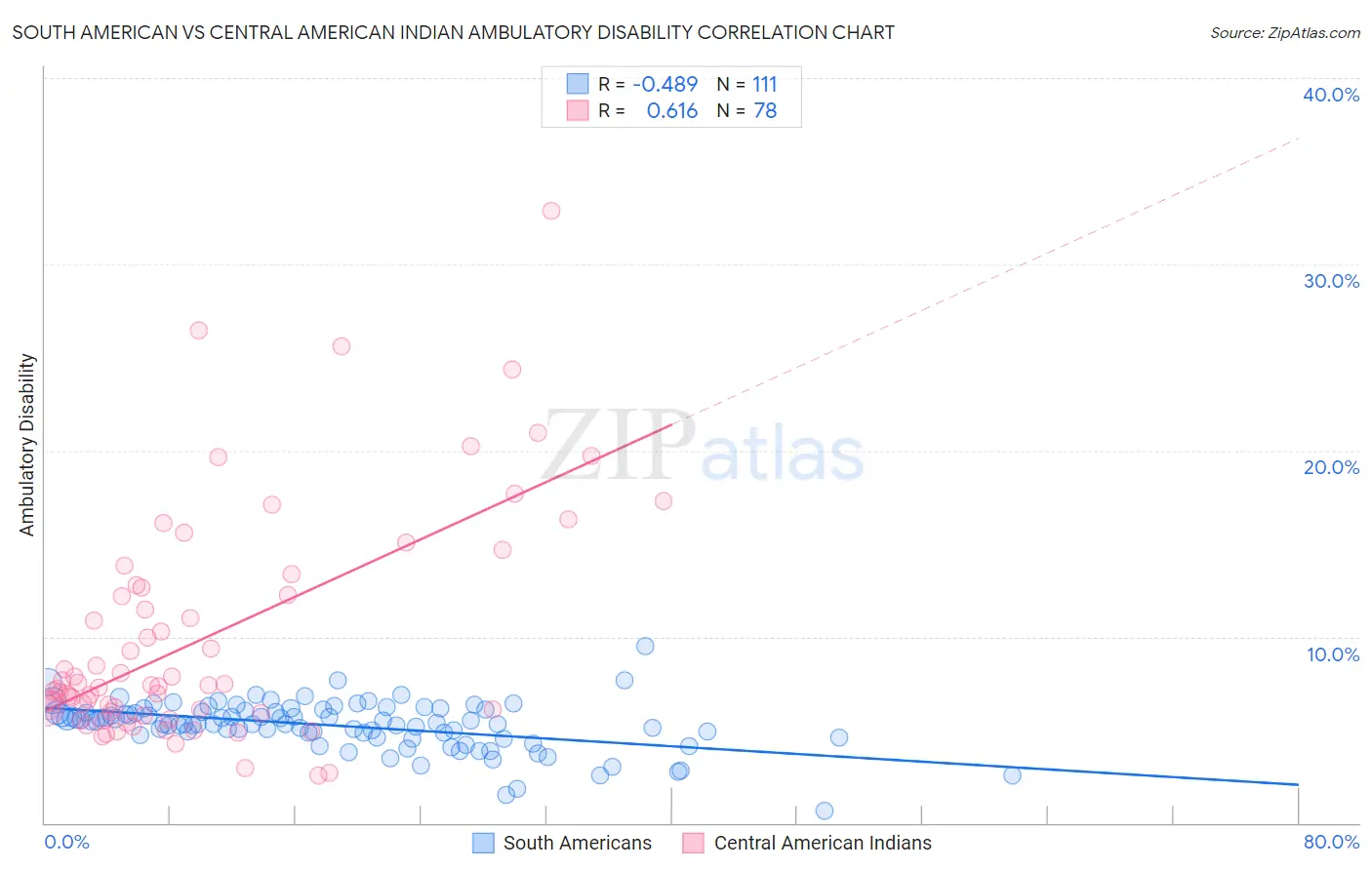South American vs Central American Indian Ambulatory Disability
COMPARE
South American
Central American Indian
Ambulatory Disability
Ambulatory Disability Comparison
South Americans
Central American Indians
5.7%
AMBULATORY DISABILITY
99.0/ 100
METRIC RATING
85th/ 347
METRIC RANK
7.2%
AMBULATORY DISABILITY
0.0/ 100
METRIC RATING
317th/ 347
METRIC RANK
South American vs Central American Indian Ambulatory Disability Correlation Chart
The statistical analysis conducted on geographies consisting of 493,855,959 people shows a moderate negative correlation between the proportion of South Americans and percentage of population with ambulatory disability in the United States with a correlation coefficient (R) of -0.489 and weighted average of 5.7%. Similarly, the statistical analysis conducted on geographies consisting of 326,071,152 people shows a significant positive correlation between the proportion of Central American Indians and percentage of population with ambulatory disability in the United States with a correlation coefficient (R) of 0.616 and weighted average of 7.2%, a difference of 24.5%.

Ambulatory Disability Correlation Summary
| Measurement | South American | Central American Indian |
| Minimum | 0.63% | 2.6% |
| Maximum | 9.5% | 32.9% |
| Range | 8.9% | 30.3% |
| Mean | 5.2% | 9.9% |
| Median | 5.3% | 7.4% |
| Interquartile 25% (IQ1) | 4.7% | 6.0% |
| Interquartile 75% (IQ3) | 6.0% | 12.6% |
| Interquartile Range (IQR) | 1.3% | 6.7% |
| Standard Deviation (Sample) | 1.3% | 6.1% |
| Standard Deviation (Population) | 1.3% | 6.0% |
Similar Demographics by Ambulatory Disability
Demographics Similar to South Americans by Ambulatory Disability
In terms of ambulatory disability, the demographic groups most similar to South Americans are Latvian (5.7%, a difference of 0.030%), Immigrants from Chile (5.8%, a difference of 0.090%), Soviet Union (5.8%, a difference of 0.14%), Eastern European (5.7%, a difference of 0.24%), and Ugandan (5.7%, a difference of 0.24%).
| Demographics | Rating | Rank | Ambulatory Disability |
| Somalis | 99.2 /100 | #78 | Exceptional 5.7% |
| Chileans | 99.2 /100 | #79 | Exceptional 5.7% |
| Immigrants | Ireland | 99.2 /100 | #80 | Exceptional 5.7% |
| Immigrants | Jordan | 99.2 /100 | #81 | Exceptional 5.7% |
| Palestinians | 99.2 /100 | #82 | Exceptional 5.7% |
| Eastern Europeans | 99.2 /100 | #83 | Exceptional 5.7% |
| Ugandans | 99.2 /100 | #84 | Exceptional 5.7% |
| South Americans | 99.0 /100 | #85 | Exceptional 5.7% |
| Latvians | 99.0 /100 | #86 | Exceptional 5.7% |
| Immigrants | Chile | 98.9 /100 | #87 | Exceptional 5.8% |
| Soviet Union | 98.9 /100 | #88 | Exceptional 5.8% |
| Bhutanese | 98.8 /100 | #89 | Exceptional 5.8% |
| Australians | 98.8 /100 | #90 | Exceptional 5.8% |
| Immigrants | Sudan | 98.8 /100 | #91 | Exceptional 5.8% |
| Immigrants | Sierra Leone | 98.6 /100 | #92 | Exceptional 5.8% |
Demographics Similar to Central American Indians by Ambulatory Disability
In terms of ambulatory disability, the demographic groups most similar to Central American Indians are Immigrants from Dominican Republic (7.1%, a difference of 0.080%), Ottawa (7.2%, a difference of 0.090%), Shoshone (7.1%, a difference of 0.32%), Blackfeet (7.1%, a difference of 0.34%), and Immigrants from Yemen (7.1%, a difference of 0.36%).
| Demographics | Rating | Rank | Ambulatory Disability |
| Arapaho | 0.0 /100 | #310 | Tragic 7.1% |
| Cree | 0.0 /100 | #311 | Tragic 7.1% |
| Delaware | 0.0 /100 | #312 | Tragic 7.1% |
| Immigrants | Yemen | 0.0 /100 | #313 | Tragic 7.1% |
| Blackfeet | 0.0 /100 | #314 | Tragic 7.1% |
| Shoshone | 0.0 /100 | #315 | Tragic 7.1% |
| Immigrants | Dominican Republic | 0.0 /100 | #316 | Tragic 7.1% |
| Central American Indians | 0.0 /100 | #317 | Tragic 7.2% |
| Ottawa | 0.0 /100 | #318 | Tragic 7.2% |
| Dominicans | 0.0 /100 | #319 | Tragic 7.2% |
| Potawatomi | 0.0 /100 | #320 | Tragic 7.3% |
| Apache | 0.0 /100 | #321 | Tragic 7.4% |
| Osage | 0.0 /100 | #322 | Tragic 7.4% |
| Americans | 0.0 /100 | #323 | Tragic 7.4% |
| Navajo | 0.0 /100 | #324 | Tragic 7.5% |